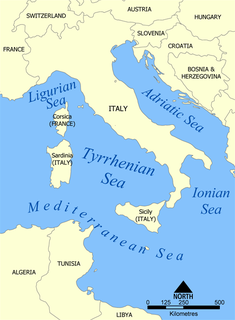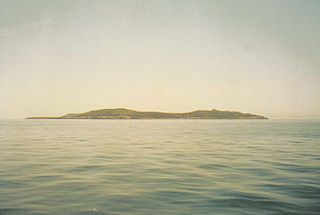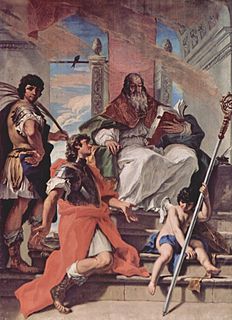
The province of Grosseto is a province in the Tuscany region of Italy. Its capital is the city of Grosseto. As of 2013 the province had a total population of 225,098 people.

The geography of Italy includes the description of all the physical geographical elements of Italy. Italy, whose territory largely coincides with the homonymous geographical region, is located in southern Europe and comprises the long, boot-shaped Italian Peninsula crossed by the Apennines, the southern side of Alps, the large plain of the Po Valley and some islands including Sicily and Sardinia. Italy is part of the Northern Hemisphere. Two of the Pelagie Islands are located on the African continent.

The Tyrrhenian Sea is part of the Mediterranean Sea off the western coast of Italy. It is named for the Tyrrhenian people identified with the Etruscans of Italy.

Giannutri is a small island in the Tyrrhenian Sea off the coast of Tuscany, Italy; it is the southernmost island of the Tuscan Archipelago and it is a frazione of the comune of Isola del Giglio in the Province of Grosseto.

Pianosa is an island in the Tuscan Archipelago in the Tyrrhenian Sea, Italy. It is about 10.25 km2 (3.96 sq mi) in area, with a coastal perimeter of 26 km (16 mi).

Montecristo, also Monte Cristo and formerly Oglasa, is an island in the Tyrrhenian Sea and part of the Tuscan Archipelago. Administratively it belongs to the municipality of Portoferraio in the province of Livorno, Italy. The island has an area of 10.39 km2 (4.01 sq mi), it is approximately 4.1 km (2.5 mi) wide at its widest point and is 3.4 km (2.1 mi) long; the coasts are steep, and extend for 16 km (9.9 mi). The island is a state nature reserve and forms part of the Tuscan Archipelago National Park.

Paolo Savi, was an Italian geologist and ornithologist.

Isola del Giglio is an Italian island and comune in the Tyrrhenian Sea, off the coast of Tuscany, and is part of the Province of Grosseto. The island is one of seven that form the Tuscan Archipelago, lying within the Arcipelago Toscano National Park. Giglio means "lily" in Italian, and though the name would appear consistent with the insignia of Medici Florence, it originally derives from the Latin name of the island, Igilium, which in turn could be related to the Ancient Greek name of the neighbouring Capraia, Αἰγύλιον, from Ancient Greek: αἴξ, romanized: aíx, lit. 'goat'.

The Tuscan Archipelago is a chain of islands between the Ligurian Sea and Tyrrhenian Sea, west of Tuscany, Italy.

Olivia of Palermo, Palermo, 448 – Tunis, 10 June 463, while according to another tradition she is supposed to have lived in the late 9th century AD in the Muslim Emirate of Sicily is a Christian virgin-martyr who was venerated as a local patron saint of Palermo, Sicily, since the Middle Ages, as well as in the Sicilian towns of Monte San Giuliano, Termini Imerese, Alcamo, Pettineo and Cefalù.

Saint Proculus was a bishop of Verona who survived the persecutions of Diocletian. He died of natural causes at Verona.

Isola delle Femmine is an Italian town in north-western Sicily, administratively part of the Metropolitan City of Palermo.

Arcipelago Toscano National Park is a large Tuscan Archipelago national park and marine park in the Provinces of Grosseto and Livorno, western Tuscany, Italy.
Ansonica or Inzolia is a white Italian wine grape planted primarily in western Sicily where it can be used to produce Marsala wine. The grape is noted for its nutty aroma. In Tuscany, the grape is known as Ansonica. It is the chief component of the Tuscan D.O.C. Ansonica Costa dell'Argentario, which is located on the extreme southern coast of Tuscany and on the island of Giglio.
Saint Libertine is venerated as a Christian martyr and as the first bishop of Agrigento, in Sicily.

San Piero in Campo is a village in Tuscany, central Italy, administratively a frazione of the comune of Campo nell'Elba, province of Livorno. At the time of the 2011 census its population was 589.

Gabriele Lancillotto Castello, prince of Torremuzza and marques of Motta d'Affermo (1727–1794) was an Italian nobleman, antiquarian, numismatist and antiquarian, most notable for his study of Sicily's coins and ancient past. He was also known as Lancellotto Castelli and wrote under the pseudonym Selinunte Drogonteo.

















